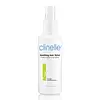What's inside
What's inside
 Key Ingredients
Key Ingredients

 Benefits
Benefits

 Concerns
Concerns

 Ingredients Side-by-side
Ingredients Side-by-side

Water
Skin ConditioningButylene Glycol
HumectantSodium Lactate
BufferingSalicylic Acid
MaskingGlycolic Acid
BufferingLactic Acid
BufferingCitric Acid
BufferingMalic Acid
BufferingTartaric Acid
BufferingNiacinamide
SmoothingSalix Nigra Bark Extract
Skin ProtectingPyrus Malus Fruit Extract
Skin ConditioningPanthenol
Skin ConditioningAllantoin
Skin ConditioningSodium Benzoate
MaskingPotassium Sorbate
PreservativeWater
Skin ConditioningGlycerin
HumectantButylene Glycol
HumectantPolysorbate 20
EmulsifyingAloe Barbadensis Leaf Extract
EmollientHamamelis Virginiana Leaf Extract
Skin ConditioningRuscus Aculeatus Root Extract
AstringentAesculus Hippocastanum Seed Extract
Skin ConditioningChamomilla Recutita Flower Extract
MaskingCentella Asiatica Leaf Extract
Skin ConditioningGlycyrrhiza Glabra Root Extract
BleachingCalendula Officinalis Flower Extract
MaskingCitrus Limon Peel Oil
MaskingLavandula Angustifolia Oil
MaskingTocopheryl Acetate
AntioxidantPhenoxyethanol
PreservativeSodium Benzoate
MaskingPropylene Glycol
HumectantAllantoin
Skin ConditioningAmmonium Glycyrrhizate
MaskingTetrasodium EDTA
Citric Acid
BufferingPanthenol
Skin ConditioningSodium PCA
HumectantEscin
TonicHydrolyzed Yeast Protein
Skin ConditioningSodium Citrate
BufferingPotassium Sorbate
PreservativeWater, Glycerin, Butylene Glycol, Polysorbate 20, Aloe Barbadensis Leaf Extract, Hamamelis Virginiana Leaf Extract, Ruscus Aculeatus Root Extract, Aesculus Hippocastanum Seed Extract, Chamomilla Recutita Flower Extract, Centella Asiatica Leaf Extract, Glycyrrhiza Glabra Root Extract, Calendula Officinalis Flower Extract, Citrus Limon Peel Oil, Lavandula Angustifolia Oil, Tocopheryl Acetate, Phenoxyethanol, Sodium Benzoate, Propylene Glycol, Allantoin, Ammonium Glycyrrhizate, Tetrasodium EDTA, Citric Acid, Panthenol, Sodium PCA, Escin, Hydrolyzed Yeast Protein, Sodium Citrate, Potassium Sorbate
Ingredients Explained
These ingredients are found in both products.
Ingredients higher up in an ingredient list are typically present in a larger amount.
Allantoin is a soothing ingredient known for its protective and moisturizingg properties. Because of this, it is often added to products with strong active ingredients.
Studies show higher concentrations of this ingredient can promote wound healing.
Though it can be derived from the comfrey plant, allantoin is produced synthetically for cosmetic products to ensure purity.
Learn more about AllantoinButylene Glycol (or BG) is used within cosmetic products for a few different reasons:
Overall, Butylene Glycol is a safe and well-rounded ingredient that works well with other ingredients.
Though this ingredient works well with most skin types, some people with sensitive skin may experience a reaction such as allergic rashes, closed comedones, or itchiness.
Learn more about Butylene GlycolCitric Acid is an alpha hydroxy acid (AHA) naturally found in citrus fruits like oranges, lemons, and limes.
Like other AHAs, citric acid can exfoliate skin by breaking down the bonds that hold dead skin cells together. This helps reveal smoother and brighter skin underneath.
However, this exfoliating effect only happens at high concentrations (20%) which can be hard to find in cosmetic products.
Due to this, citric acid is usually included in small amounts as a pH adjuster. This helps keep products slightly more acidic and compatible with skin's natural pH.
In skincare formulas, citric acid can:
While it can provide some skin benefits, research shows lactic acid and glycolic acid are generally more effective and less irritating exfoliants.
Most citric acid used in skincare today is made by fermenting sugars (usually from molasses). This synthetic version is identical to the natural citrus form but easier to stabilize and use in formulations.
Read more about some other popular AHA's here:
Learn more about Citric AcidPanthenol is a common ingredient that helps hydrate and soothe the skin. It is found naturally in our skin and hair.
There are two forms of panthenol: D and L.
D-panthenol is also known as dexpanthenol. Most cosmetics use dexpanthenol or a mixture of D and L-panthenol.
Panthenol is famous due to its ability to go deeper into the skin's layers. Using this ingredient has numerous pros (and no cons):
Like hyaluronic acid, panthenol is a humectant. Humectants are able to bind and hold large amounts of water to keep skin hydrated.
This ingredient works well for wound healing. It works by increasing tissue in the wound and helps close open wounds.
Once oxidized, panthenol converts to pantothenic acid. Panthothenic acid is found in all living cells.
This ingredient is also referred to as pro-vitamin B5.
Learn more about PanthenolPotassium Sorbate is a preservative used to prevent yeast and mold in products. It is commonly found in both cosmetic and food products.
This ingredient comes from potassium salt derived from sorbic acid. Sorbic acid is a natural antibiotic and effective against fungus.
Both potassium sorbate and sorbic acid can be found in baked goods, cheeses, dried meats, dried fruit, ice cream, pickles, wine, yogurt, and more.
You'll often find this ingredient used with other preservatives.
Learn more about Potassium SorbateSodium Benzoate is a preservative. It's used in both cosmetic and food products to inhibit the growth of mold and bacteria. It is typically produced synthetically.
Both the US FDA and EU Health Committee have approved the use of sodium benzoate. In the US, levels of 0.1% (of the total product) are allowed.
Sodium benzoate works as a preservative by inhibiting the growth of bacteria inside of cells. It prevents the cell from fermenting a type of sugar using an enzyme called phosphofructokinase.
It is the salt of benzoic acid. Foods containing sodium benzoate include soda, salad dressings, condiments, fruit juices, wines, and snack foods.
Studies for using ascorbic acid and sodium benzoate in cosmetics are lacking, especially in skincare routines with multiple steps.
We always recommend speaking with a professional, such as a dermatologist, if you have any concerns.
Learn more about Sodium BenzoateWater. It's the most common cosmetic ingredient of all. You'll usually see it at the top of ingredient lists, meaning that it makes up the largest part of the product.
So why is it so popular? Water most often acts as a solvent - this means that it helps dissolve other ingredients into the formulation.
You'll also recognize water as that liquid we all need to stay alive. If you see this, drink a glass of water. Stay hydrated!
Learn more about Water